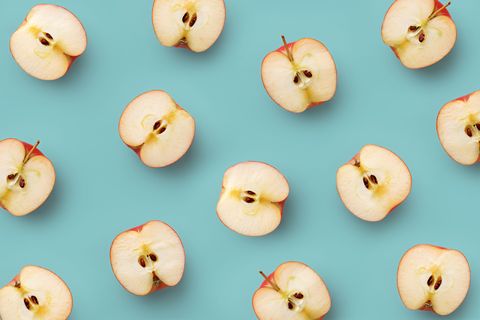
The moment signs of a vaginal yeast infection make themselves known—the itch you discreetly get at by squirming in your seat, the gates of hell suddenly relocating to between your legs, and the clumpy discharge—nothing else matters…other than getting it gone.
The internet seems to think a possible hero might be the trendiest new cure-all: apple cider vinegar. I mean, it seems capable of promoting everything from smooth skin to healthy hair…so why not?
Wait, how do I know I have a yeast infection?
A yeast infection, or candidiasis, is caused by a fungus called Candida and it loves dark, wet spaces like mouths, throats, and (you guessed it) vaginas. It’s totally harmless until it multiplies—that’s when trouble starts, according to the Centers for Disease Control (CDC).
If the material of your underwear doesn’t allow for breathability (cotton’s always a good choice; silk, not so much), or if you’re taking an antibiotic which can kill bacteria that normally protects the vagina, for example, Candida might multiply, leaving you infected.
Yeast infections come with a side of symptoms that include the very common itching, as well as burning, redness, swelling, pain during sex, pain while peeing, soreness, and thick discharge, according to the Office on Women’s Health (OWH).
While they’re uncomfortable, yeast infections are super common. OWH indicates three out of four women will have a yeast infection at least once in their lives.
So about apple cider vinegar…can it clear up a yeast infection?
Some people seem to think so. Internet theories promoting direct application of diluted vinegar, including douching with it and inserting a vinegar-soaked tampon are floating around out there just begging for investigation.
The verdict: You should not be doing any of this.
Lauren Streicher, M.D., a clinical professor of obstetrics and gynecology at Northwestern University and author of Sex RX, said it best: “Use apple cider vinegar on your salad and not your vagina.”
That means keep the stuff away from your vagina in any form—especially through douching or ACV-soaked tampons. I mean, ACV is acidic, so you’re just asking for extra irritation to the vulvar skin and vaginal tissue, says Streicher.
TBH, douching overall is a vaginal no-no, she says. “There’s no medical reason for douching, and, in fact, scientific evidence is quite clear that douching can be detrimental,” says Streicher, adding that it can eliminate all of the bacteria in your vagina, including the good stuff.
Okay, fine. So how can I treat a yeast infection?
The good news: Yeast infections are easy to get rid of.
You can take antifungal medication which you can get over the counter or prescribed by a doctor. They might come in the form of cream suppositories and oral treatments, Streicher says.
She is all for over-the-counter medications, but warns: “almost half the time that women think they have yeast infections, they don’t,” so you have to be sure you really have one. If after a few days of using an antifungal, you’re still experiencing symptoms, you might actually have an STI or bacterial vaginosis, in which case you should go to a doctor for a diagnosis and proper treatment.
Depending on what kind of antifungal medication you take and how complicated your strain, a yeast infection should clear within one to 14 days, according to AZO, an OTC antifungal for yeast infections.
While you’re at it, try taking a cool bath (sans vinegar—that’s another half-assed yeast infection treatment suggestion). Though it won’t treat your yeast infection, it “might make you feel a little better,” says Streicher, since the cool water can help dull the itching and burning.
The bottom line: Again, Streicher said it best: “If it’s in your kitchen it should go in your mouth, not your vagina.” Amen.
Source: Read Full Article
